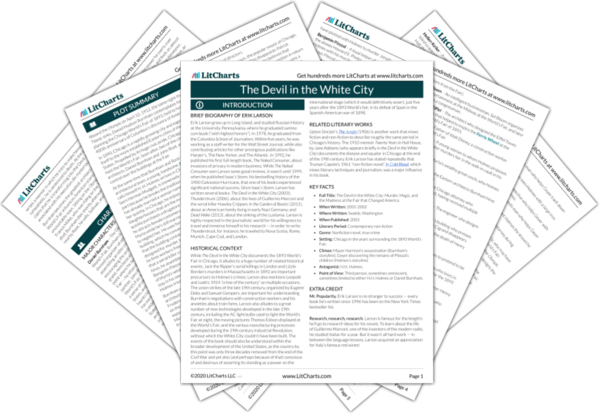Welcome to the LitCharts study guide on Erik Larson's The Devil in the White City. Created by the original team behind SparkNotes, LitCharts are the world's best literature guides.
Devil in the White City: Introduction
A concise biography of Erik Larson plus historical and literary context for The Devil in the White City.
Devil in the White City: Plot Summary
A quick-reference summary: The Devil in the White City on a single page.
Devil in the White City: Detailed Summary & Analysis
In-depth summary and analysis of every chapter of The Devil in the White City. Visual theme-tracking, too.
Devil in the White City: Themes
Explanations, analysis, and visualizations of The Devil in the White City's themes.
Devil in the White City: Quotes
The Devil in the White City's important quotes, sortable by theme, character, or chapter.
Devil in the White City: Characters
Description, analysis, and timelines for The Devil in the White City's characters.
Devil in the White City: Symbols
Explanations of The Devil in the White City's symbols, and tracking of where they appear.
Devil in the White City: Theme Wheel
An interactive data visualization of The Devil in the White City's plot and themes.
Brief Biography of Erik Larson
Erik Larson grew up in Long Island, and studied Russian History at the University Pennsylvania, where he graduated summa cum laude (“with highest honors”). In 1978, he graduated from the Columbia School of Journalism. Within five years, he was working as a staff writer for the Wall Street Journal, while also contributing articles for other prestigious publications like Harper’s, The New Yorker, and The Atlantic. In 1992, he published his first full-length book, The Naked Consumer, about invasions of privacy in modern business. While The Naked Consumer won Larson some good reviews, it wasn’t until 1999, when he published Isaac’s Storm, his bestselling history of the 1900 Galveston Hurricane, that one of his books experienced significant national success. Since Isaac’s Storm, Larson has written several books: The Devil in the White City (2003); Thunderstruck (2006), about the lives of Guillermo Marconi and the serial killer Hawley Crippen; In the Garden of Beasts (2011), about an American family living in early Nazi Germany; and Dead Wake (2013), about the sinking of the Lusitania. Larson is highly respected in the journalistic world for his willingness to travel and immerse himself in his research — in order to write Thunderstruck, for instance, he traveled to Nova Scotia, Rome, Munich, Cape Cod, and London.
Get the entire Devil in the White City LitChart as a printable PDF.

Historical Context of The Devil in the White City
While The Devil in the White City documents the 1893 World’s Fair in Chicago, it alludes to a huge number of related historical events. Jack the Ripper’s serial killings in London and Lizzie Borden’s murders in Massachusetts in 1892 are important precursors to Holmes’s crimes; Larson also mentions Leopold and Loeb’s 1924 “crime of the century” on multiple occasions. The union strikes of the late 19th century, organized by Eugene Debs and Samuel Gompers, are important for understanding Burnham’s negotiations with construction workers and his anxieties about train fares. Larson also alludes to a great number of new technologies developed in the late 19th century, including the AC light bulbs used to light the World’s Fair at night, the moving pictures Thomas Edison displayed at the World’s Fair, and the various manufacturing processes developed during the 19th century Industrial Revolution, without which the White City couldn’t have been built. The events of the book should also be understood within the broader development of the United States, as the country by this point was only three decades removed from the end of the Civil War and yet also (and perhaps because of that) conscious of and desirous of asserting its standing as a power on the international stage (which it would definitively assert, just five years after the 1893 World’s fair, in its defeat of Spain in the Spanish-American war of 1898.
Other Books Related to The Devil in the White City
Upton Sinclair’s The Jungle (1906) is another work that mixes fiction and non-fiction to describe roughly the same period in Chicago’s history. The 1910 memoir Twenty Years in Hull House, by Jane Addams (who appears briefly in the Devil in the White City) documents the disease and squalor in Chicago at the end of the 19th century. Erik Larson has stated repeatedly that Truman Capote’s 1961 “non-fiction novel” In Cold Blood, which mixes literary techniques and journalism, was a major influence in his book.
Key Facts about The Devil in the White City
- Full Title: The Devil in the White City: Murder, Magic, and the Madness at the Fair that Changed America
- When Written: 2001-2002
- Where Written: Seattle, Washington
- When Published: 2003
- Literary Period: Contemporary non-fiction
- Genre: Nonfiction novel, true crime
- Setting: Chicago in the years surrounding the 1893 World’s Fair.
- Climax: Mayor Harrison’s assassination (Burnham’s storyline), Geyer discovering the remains of Pitezal’s children (Holmes’s storyline)
- Antagonist: H.H. Holmes.
- Point of View: Third person, sometimes omniscient, sometimes limited to either H.H. Holmes or Daniel Burnham.
Extra Credit for The Devil in the White City
Mr. Popularity. Erik Larson is no stranger to success — every book he’s written since 1996 has been on the New York Times bestseller list.
Research, research, research. Larson is famous for the length’s he’ll go to research ideas for his novels. To learn about the life of Guillermo Marconi, one of the inventors of the modern radio, he studied Italian for a year. But it wasn’t all hard work — in between the language lessons, Larson acquired an appreciation for Italy’s famous red wines!












